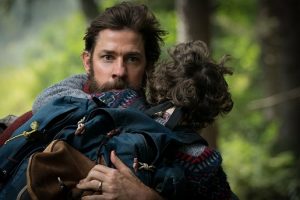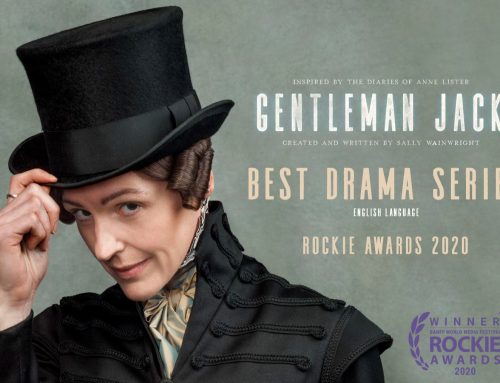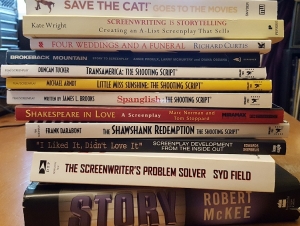by Renée J. Lukas
 “If they hear you, they hunt you.” This summer, a refreshingly smart thriller came into theaters, and it takes you on a fun ride from start to finish. I was kind of disappointed when the lights came up.
“If they hear you, they hunt you.” This summer, a refreshingly smart thriller came into theaters, and it takes you on a fun ride from start to finish. I was kind of disappointed when the lights came up.
(WARNING: Spoilers ahead.)
‘A Quiet Place’ is a New Kind of Thriller
If you like your scary movies with faceless serial killers who chase half-naked women into forests, go see another movie. A Quiet Place is for audiences that are looking for something different.
When I went to see this movie, I knew the basic premise: a family tries to survive in a world where they’re being hunted by aliens that use sound to find their prey. Not only is this a clever concept, but the story in A Quiet Place brings depth to this genre that’s a welcome change. Issues between a father and daughter, or a husband and wife trying to carve out some normality in the midst of terror—these moments enrich the story so much more.
My first mistake, however, was ordering popcorn. Because it’s a quiet movie in many parts, you almost don’t want to chew anything.
What I liked most were the little moments. A scene where Evelyn Abbott (Emily Blunt) steps on a nail is far more horrific than all the big-budget explosions we often see in movies. Because nobody can make a sound, the stakes are that much higher. And you realize how you take for granted the times in your daily life when you may need to make a sound—like, say, when giving birth.
In many ways, this film proves that smaller is better than bigger. When you think of all the bigger special effects, and movies that are trying to top themselves in these ways, ‘A Quiet Place’ really proves to be a cut above, using suggestive, small moments for maximum impact. And it works.
What Screenwriters Can Learn from ‘A Quiet Place’
The stakes are established early on. Within the first twenty minutes of the film, you see how a child’s toy can cause that child to be snatched up so fast and eaten by a toothy creature. This shows us immediately how high the stakes are and why it is so necessary for the family to move barefoot along a path without making a sound. When you know the price they could pay, you feel for them and find yourself trying to be quiet along with them. Again, I had a hard time chewing my popcorn. . .
This is a family you can root for. Nothing takes an audience on a real ride until they feel like they’re sharing the experience with the characters. Seeing the real love between the couple and their love for their children—these are people we can root for. Although it is a little funny how Evelyn still feels the need to teach her child long division in the middle of an apocalypse. . .you sort of assume they’re trying to keep life as normal as possible. And minus the sound, this family has all the issues of any other family—a sister’s guilt when she feels responsible for her brother’s death, and her fear that her father still blames her, and a wife’s desperate insistence that her husband protect the kids no matter what.

They show more than tell. Because of obvious reasons, the film relies heavily on visual communication, which, after all, is what film truly is. Even though I love some clever dialogue, this film makes great use of scenes with high visual impact. At the very beginning, still shots of a decimated town tell you something dreadful has happened. Assorted newspaper headlines tell the story of what the family is now dealing with. This is a great example of how you don’t need to use heavy exposition scenes to explain. A simple headline that reads: “It’s Sound!” shows heartbreakingly how the human race had tried to figure out what made the aliens attack. It inspired me to think more creatively about how to get across information. I’ve never been one to use monologues overstuffed with exposition, but there are always little details you might not think about that could do the trick nicely. I love seeing a movie that makes me want to be a better writer.
The ending works. I’ve been focused on endings lately, struggling with that difficult saying: “They should feel inevitable, yet surprising.” I often ask myself how something can feel inevitable without being somehow predictable. It’s like an impossible math equation. But the key is getting there, to where the audience expects, in a way they didn’t expect. I liked how this film ended on a hopeful note. Seeing the aliens coming toward the house, you know that Evelyn and her daughter have figured out how to stop them once and for all. One quick shot of Evelyn readying her gun, then cutting to black—that’s all we need to feel hopeful when the credits roll. Some directors would add a scene of creature guts exploding, thinking that’s more satisfying to include. But no. We don’t need that.
So kudos to John Krasinski, Bryan Woods and Scott Beck for crafting a surprising thriller, which is so tough to do these days when audiences feel like they’ve seen it all. They really haven’t seen anything like this before.



